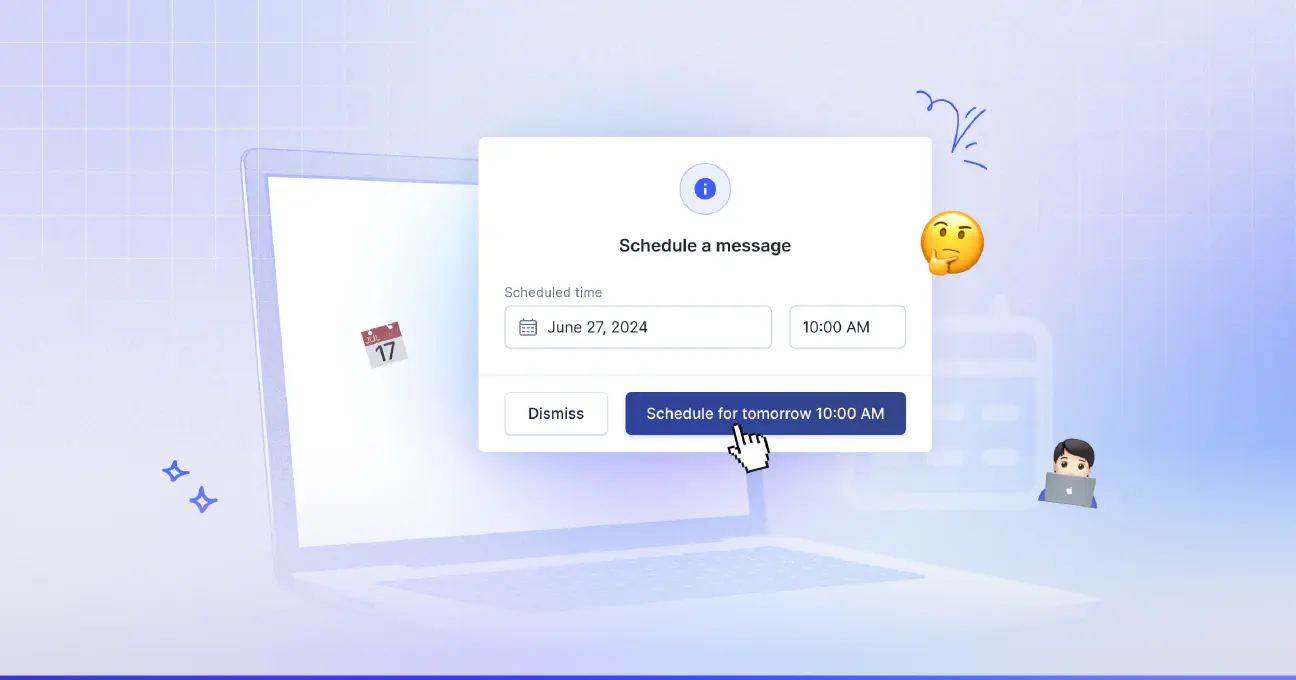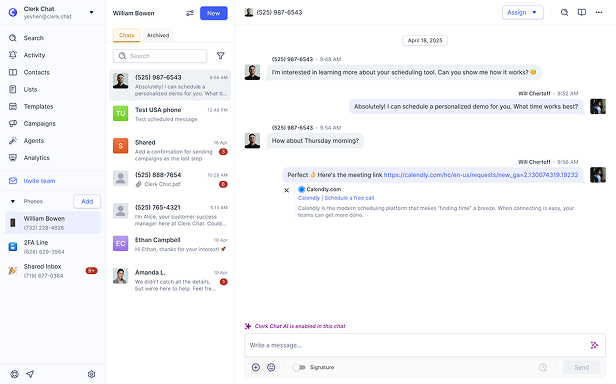What is Donor Engagement and Why it’s the Key to Nonprofit Growth
By Alexander Haque
- Published: June 24, 2025
Key points in this article:
- Donor engagement is crucial for nonprofit growth. It fuels donations, advocacy, and long-term support from your community.
- Effective donor engagement goes beyond one-time gifts; it builds lasting relationships through recognition, updates, and consistent communication.
- Measuring donor engagement means tracking more than donations. Look at event attendance, volunteer hours, social shares, and communication metrics.
- Strategies to improve engagement include sharing compelling content, telling donor stories, leveraging social media, and using omnichannel messaging tools.
- Personalized communication is key. Tailor messages, show appreciation, and keep donors in the loop with transparent updates and easy access to your team.
- Technology, especially platforms like Clerk Chat, plays a vital role in automating outreach, improving engagement data analysis, and offering real-time donor support.
- Conversational AI and intelligent messaging tools make it easier than ever to keep your donors informed, appreciated, and inspired to give more.
For nonprofit organizations, few things matter more than earning and maintaining donor engagement. After all, your donors aren’t just the people who fund your cause. They’re also some of your organization’s biggest advocates and champions.
Earning high levels of engagement, whether by using an intuitive texting service for nonprofits to keep your community informed or by constantly rewarding and recognizing donors for their support, ensures your organization continues to grow.
On the other hand, if your donor engagement levels start to dwindle, you could find that you don’t have the financial support or reach you need to achieve your world-changing goals.
So, how exactly do you engage donors – and more importantly – keep them engaged throughout their relationship with your nonprofit group?
In this article:
What is Donor Engagement?
Donor engagement refers to how involved and invested your donors are in your organization. Anyone can make a one-off donation on a whim when they’re feeling generous, but that doesn’t make them a truly committed member of your community.
An engaged donor doesn’t just use your “text to donate” number once and forget about you. They play an active role in supporting your cause. They might raise awareness of the problem you want to solve, encourage other people to donate, participate in volunteer events, or even sign up to make regular, monthly donations. The more engaged your donors are, the more value they offer.
That’s why nonprofit organizations need a comprehensive donor engagement strategy to delight, support, and retain donors, just like for-profit companies focus on keeping customers.
Struggling to keep donors engaged?
Clerk Chat makes every message count.
Understanding the Donor Engagement Cycle
To master donor engagement, you need an understanding of the “donor engagement cycle.” Just as customers go through a sales cycle, or “buyer journey,” with a company, starting with awareness and progressing through conversion and retention, donors follow a similar process.
While the nuances of the cycle can vary, it often includes the following stages:
Cultivation
Most nonprofits don’t randomly contact potential prospects and ask them to make a donation. Not only does this strategy rarely work, but it also puts your organization at risk. For instance, TCPA compliance laws and 10DLC registration guidelines prevent organizations from contacting customers without first gaining consent.
During the cultivation stage, nonprofits focus on attracting donors to their cause, researching potential donors, creating content that might capture their attention, and encouraging them to share their contact details. For instance, you might host an event (online or offline) where you share stories about the work you’ve been doing, and ask new donors to get involved.
Alternatively, you might create online content that encourages customers to sign up for a charity texting subscription to hear about your latest accomplishments.
Solicitation
After your nonprofit marketing efforts have attracted the attention of potential donors and provided insights into your work, you can start asking for support. Notably, you don’t have to ask for financial contributions immediately.
Instead, you might send out scheduled text messages asking leads to get involved with upcoming volunteer events, or request their insights on improving your work. After you’ve built a strong enough relationship with your potential donor, you can ask them whether they’d be willing to give a one-off donation.
After a while, you might even encourage them to sign up to send “long-term” regular donations to your group automatically, using a donation program with a text-to-join feature.

Stewardship
The Stewardship phase happens after your donor has already given something to your organization. At this point, you focus on maintaining donor engagement and building on that existing relationship. For instance, you might send out personalized text messages to each donor, thanking them for their contributions and sharing insights into what they helped you achieve.
Or you might create a monthly newsletter to share with your community, with stories from the people and groups you might be helping. You could even invest in hosting regular events, designed to bring your donors together, and teach them more about your organization.
The idea is to constantly strengthen your relationship with your community so that your contributors feel invested in your organization and continue to help it grow.
Measuring Donor Engagement
Since how donors show engagement can vary through each stage of the donor engagement cycle, there’s more than one way to measure just how invested your supporters are. You should be tracking things like the overall number and value of donations you get from month to month.
However, you might also need to pay attention to KPIs and metrics like:
- The number of attendees who visit your events
- How many donors volunteer to support your organization
- How many hours do donors spend volunteering
- The number of surveys and feedback responses to get
- Social media followers, likes, and comments
- Reposts and shares of articles and stories
- Email and SMS open and click-through rates
- Years spent as a donor (or retention rates)
- Website visits or clicks
Tracking all of these metrics is helpful for numerous reasons. It doesn’t just help you determine whether your donor engagement strategies are working. It also lets you learn more about your supporters and what drives them to stay connected with your cause.
The Importance of Donor Engagement
So, why do you need a donor engagement strategy?
The simple answer is that your supporters or backers are the heart of your nonprofit organization. They’re not just the people who fund your altruistic efforts – they’re also the volunteers who work with you to achieve your goals and drive others to donate.
Investing in donor engagement means you benefit from:
- Improved Donation and Retention Rates: Studies show that 70% of donors think it’s essential to trust a charity before they give anything. Focusing on engaging and informing your supporters helps you to earn that trust and keep donors close.
- Reduced Costs: With backers’ time and support, you can spend less money hiring staff for events and even launching marketing campaigns. Donors can also drive new supporters to your organization, saving you time and money.
- Increased Donations: Long-term, dedicated support delivers consistent support to your non-profit. According to one report, the average lifetime value of a recurring backer is over $7,600 (more than double that of a one-time donor).
A strategy for donor engagement ensures you can take a proactive approach to unlocking all of those benefits, building stronger relationships with a careful approach to nonprofit communications.
How to Engage Donors: Donor Engagement Strategies
Ultimately, building and maintaining donor engagement requires ongoing effort. There’s more to it than just launching a single marketing campaign or occasionally updating your backers with SMS marketing campaigns. Here are some great strategies you can use to boost engagement levels.
1. Create and Share Compelling Content
This strategy is particularly crucial for those wondering how to engage donors at the start of the engagement cycle. When prospective supporters are unaware of your cause or what your organization does, they need a compelling reason to support you.
Creating compelling content is a great way to show people why they should be backing you. Create articles, blog posts, and even videos you can share across channels. These pieces of content should highlight how you plan to use your donations, the goals you’ve already achieved, and even the recognition you’ve earned from regulatory bodies and other groups.
They should draw attention to your unique mission and vision, and transparently inform audiences how their donations will help you change the world for the better. Be experimental with your content. Don’t just share blogs and articles. Use graphs, charts, and images across multiple platforms and channels to highlight your impact in a compelling way.
2. Share Donor Stories
Various forms of content can boost nonprofit donor engagement levels, particularly during the early stages of the engagement cycle. However, few things will resonate with your community more than stories from real people who have already helped support your brand.
Sharing a story about how a particular donor helped you achieve a fantastic goal by launching a fundraising campaign, making a huge donation, or even just raising awareness for your organization, encourages other people to get involved. It also helps show your supporters how much you appreciate and recognize their efforts.
Again, take advantage of immersive storytelling here. Share real-world quotes from people connected to your organization. Create videos, blogs, and newsletters. Call out your donors by name on your social media walls and tag them in posts.
You can even ask your donors to become ambassadors for your brand, sharing their stories with their communities across various digital channels.
3. Activate Your Social Media Strategy
If you’re not already using social media for conversational marketing, customer service, and donor engagement, you should be. Social media is one of the best ways to keep your community updated and informed about what your organization is doing.
Through channels like Instagram, TikTok, Facebook, and X (Twitter), you can share your accomplishments, the challenges you’re trying to overcome, and even recognize your top donors and volunteers. You can also gather insights from people interested in supporting your cause.
Invest in a consistent posting schedule to keep your audience engaged and educated. Use a mixture of content types (photos, videos, and text-based updates). Experiment occasionally with different experiences, like giveaways, challenges, or live streams.
4. Invest in Omnichannel Communication
Email is still a great way to connect with nonprofit supporters, but messages can easily get lost in a crowded inbox or spam folder. You need to think beyond email to boost your chances of reaching your audience more consistently.
While you might continue to use email campaigns for in-depth newsletters, invest in a bulk SMS platform to send shorter updates and alerts to your community. Consider investing in group texting solutions to align and synergize backers who want to volunteer for upcoming events.
Strengthen your strategy for answering common donor questions with AI for customer experience. AI tools built into messaging platforms can help handle queries about upcoming events or donation options. They can also proactively engage potential supporters with news about new opportunities or reminders about fundraising experiences.
Struggling to keep donors engaged?
Clerk Chat makes every message count.
5. Create a Membership Program
Membership programs aren’t just for commercial companies. They can also be great for boosting donor engagement for nonprofits. An attractive membership program—one that offers participants access to exclusive events or insider updates, can help you attract more leads to your organization, encouraging people to “opt-in” to your SMS marketing strategy.
Membership programs also help you actively reward your contributors, whether with personalized thank-you messages from board members or the communities you serve, or with access to exclusive giveaways and branded gifts.
Plus, with a membership program, you’ll have direct access to a community of active audience members who can constantly give you insights into potential donors’ preferences and the reasons they choose to support your organization.
6. Host Regular Events
While conversational messaging strategies and digital marketing campaigns are great for building relationships with backers, few things forge emotional connections quite like special events. Events boost donor engagement by rewarding active supporters with exclusive experiences.
They also give you an excellent opportunity to provide access to unique knowledge and resources, from case studies on your accomplishments to fundraising workshops. You don’t necessarily need to host these events in person either. You can host online webinars, virtual auctions, and galas.
You might even launch regular meet-and-greet events with your organization’s leaders or members of the community you serve. These experiences encourage active involvement from your community and help strengthen loyalty.
7. Encourage Donors to Volunteer
Remember, a donor can support your non-profit in more than one way. Not every backer will be able to donate huge amounts of cash every month, but they might be able to help you grow by volunteering for fundraising events or activities.
The great thing about volunteering opportunities is that they don’t just give you access to valuable resources – they give your supporters a first-hand view of the work you’re doing. This generally makes people feel more committed and passionate about your cause.
Over time, this can lead to higher donation rates, too. One report found that around 85% of volunteers regularly donate to the nonprofits they help. Get creative with your volunteering opportunities, allowing community members to suggest their own ways to raise money or assist your cause.
After each event or experience, gather feedback and insights you can use in future marketing campaigns.
Top Tips for Better Donor Engagement
We’ve covered some of the top donor engagement strategies nonprofits can use, but before you start exploring these options, it’s worth mastering some best practices. Here are some crucial top tips to follow as you dive into your new strategy.
1. Conduct Extensive Research
The more you know about your potential donors, the easier it will be to create content and campaigns that engage, inform, and inspire them. Conduct focus groups, market research, and gather insights from existing backers to help you understand what motivates your community.
Use the information you collect to personalize and enhance your donor engagement efforts. For instance, you can use your CRM data and backer feedback to divide supporters into different groups based on their giving frequency (or value), location, and interests.
From there, you can create marketing campaigns (such as mass texting campaigns) specifically tailored to the needs of different groups.
2. Personalize Every Message
About 72% of customers say they’ll only engage with personalized messages, and that applies to donors for your nonprofit, too. Make your backers feel special by tailoring every message you send to them. Refer to them by name when you send out mass texts with dynamic fields in messages.
Reference the past contributions of donors when you’re messaging them asking for further support or donations, and thank them constantly for everything they’ve done so far. Make sure you’re reaching out to your supporters on the channel they prefer, at a time appropriate for them, with scheduling software and dynamic cohorts.
You could even allow your backers to choose when and how they hear from you by asking them to text SMS keywords to your company, identifying the kind of updates they want to receive.
3. Prioritize Donor Recognition and Appreciation
One of the biggest mistakes you can make when investing in donor engagement is only reaching out to your backers when you want something from them. You shouldn’t just send messages asking for donations or voluntary support; you should also thank them for what they do.
When a supporter donates, use an AI-powered SMS tool to thank them wholeheartedly for their contribution. At regular intervals, give them updates on your accomplishments to show them how they’re supporting your work.
Feature your top supporters in your email newsletters, your website, and even your social media channels (with their permission). You could even create little bios explaining why they decided to support your cause (which could help to convert other backers).
4. Maintain Open Communication
Aside from regularly recognizing your donors and keeping them up-to-date on contribution opportunities, make sure you’re maintaining open communication about other things, too. Let your donors know when you’re facing challenges or when you accomplish something new.
Share regular reports about how you’re spending their money and your goals for the next few months or years. You can do this with a text blast service, scheduling regular notifications to keep everyone in your community up-to-date.
Additionally, ensure your community can easily reach you with any questions. If you don’t have the money to invest in a customer service team, use AI for nonprofit organizations to field frequently asked questions 24/7.
5. Create a Donor Feedback Loop
Your supporters are a valuable source of information, so take advantage. Send out surveys asking for feedback on how you can improve. Ask your backers for tips on how to enhance your marketing strategies or what projects you should focus on next.
Ask them directly why they chose to contribute to your cause, and what might encourage them to stick with you long-term. Requesting feedback doesn’t just boost donor engagement – it shows your backers that you genuinely value their input.
Plus, if you act on their suggestions, donors can feel more invested in your cause because they’re shaping your organization’s future. Feedback also ensures you can build more impactful marketing campaigns and strategies that might help you attract the attention of other supporters.
6. Use Technology for Nonprofit Donor Engagement
Finally, technology is an incredible resource for nonprofits that need to boost donor engagement. CRM solutions can help you gather insights about your community and create more personalized, relevant marketing campaigns. Collaboration tools and platforms can help you unify donors for events and volunteering experiences.
Communication platforms like Clerk Chat make sure you keep donors actively engaged throughout the donor engagement cycle. You can use them to create personalized messaging campaigns that provide backers with updates, insights into upcoming events, and donation ideas. You can even use SMS appointment reminders to boost event attendance or encourage backers to renew their subscriptions to a monthly donation service.
AI is another fantastic tool to take advantage of. With agentic AI workflows, nonprofits can automate a range of tasks, from creating marketing content to distributing it across channels, measuring results, and collecting feedback.
Conversational AI solutions can also help you answer donor questions faster, convert potential backers into lifelong supporters, and deliver rewards and recognition to your community.
Plus, AI tools can help you dive deeper into your engagement data, giving you insights into the best ways to improve engagement rates by fine-tuning your content, adjusting your publishing schedule, or using new targeting methods.
Upgrade Your Donor Engagement Strategy
Your donors are the beating heart of your nonprofit organization. Keeping them informed and engaged is crucial to ensuring you continue to earn the funding and support you need to drive your cause forward. Unfortunately, donor engagement can be hard to master.
That’s where the right technology makes all the difference. Clerk Chat, a leading conversational messaging platform, helps nonprofits build deeper relationships with supporters.
With tools to help you segment audiences into groups, personalize comprehensive campaigns across messaging channels, and even support donors in real-time with conversational AI, Clerk Chat does more than boost engagement. It ensures you can proactively turn supporters into active advocates for your brand. Ready to unlock the true power of donor engagement? Contact Clerk Chat today.
Alex is passionate about building truly groundbreaking technology that serves humanity. He strives to encourage work environments where teams show up authentically and are empowered to contribute their best work. Before Clerk Chat, Alex built, scaled, and sold Retinad VR, followed by working in partnerships and innovation at Samsung and Netflix, helping enable large-scale projects and products. In his free time you can find him gravel biking and reading philosophy.
In this article:
Ready to use your business number for text messaging?
Thousands of businesses are already experiencing the power of conversational messaging through SMS. Join us. Free trial and paid tiers available.
Get Started#Subscribe
Get product updates in your inbox
Tutorials, features, and Clerk Chat news delivered straight to you.




